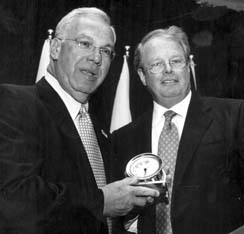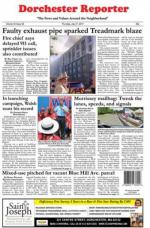April 6, 2011
Peter Meade is well-respected as both an out-front power broker and a behind-the-scenes adviser to some of the region’s most influential civic and business leaders. He is an inspired choice to lead the city’s planning agency, the Boston Redevelopment Authority or BRA.
 Mayor Tom Menino with Peter MeadeMeade’s imminent tenure is sure to be consumed quickly by large development questions that have bedeviled Boston even before the recent recession: the Filene’s hole in downtown Boston, the Ferdinand building in Dudley Sq. and the continued development of the waterfront. All of these projects — and many more—will benefit from Meade’s unique skill set and his productive relationship with Mayor Menino.
Mayor Tom Menino with Peter MeadeMeade’s imminent tenure is sure to be consumed quickly by large development questions that have bedeviled Boston even before the recent recession: the Filene’s hole in downtown Boston, the Ferdinand building in Dudley Sq. and the continued development of the waterfront. All of these projects — and many more—will benefit from Meade’s unique skill set and his productive relationship with Mayor Menino.
Closer to home, Meade’s roots in our neighborhood present a fresh opportunity to re-cast the city agency’s relationship with Dorchester and Mattapan, which have often been treated clumsily by city planners.
Meade told the Reporter this week that he intends to “listen and learn more” about how the BRA engages and is viewed by the neighborhoods. He comes to the job, he says, with great admiration for the agency’s professional staff— which Mayor Tom Menino characterizes as “some of the most talented urban planners” in the country.
But the BRA also has an unfortunate track record of callous disregard for neighborhood history and identity. Four decades ago, the agency codified racial lines of residential segregation here in Dorchester by dividing the neighborhood into two separate regions, north and south. It was a bad idea then. Now, it is not only wrong, but it perpetuates a myth about a neighborhood that has diversified and grown in ways that make the regional distinction confusing and, well, silly. Other neighborhoods— including Jamaica Plain and Roxbury— have similar complaints about the BRA’s performance when it comes to respecting the historic and cultural identities of each community.
Last week, we detailed how BRA planners have once again shifted the neighborhoods’ boundary lines to present data for the 2010 census. The result is that statistics about population totals and demographics by neighborhood are badly flawed. Although BRA officials were quick to offer customized maps to those of us who disagree with their changes on a case-by-case basis, the fact remains that the city’s official position is just plain wrong— and that can only serve to sow confusion and flawed policy decisions in years to come.
If city planners need to work with a smaller geographic zone, that should be an internal exercise, not one that is imposed on the public at large by an un-elected bueracracy. Meade should act early to wipe this Dorchester divide off city maps once and for all. It’s job one for anyone who hopes to re-build credibility that has been worn thin.
Correction
A story and headline in the March 24 Reporter (Aerosmith’s Hamilton plugs in at Blue Hill clubhouse”) incorrectly stated the location of a jam session featuring Aerosmith bassist Tom Hamilton and Berklee College of Music alumni Swiss Chris. The event happened at the Boys and Girls Clubs of Dorchester on Dorchester Avenue.
Topics:



